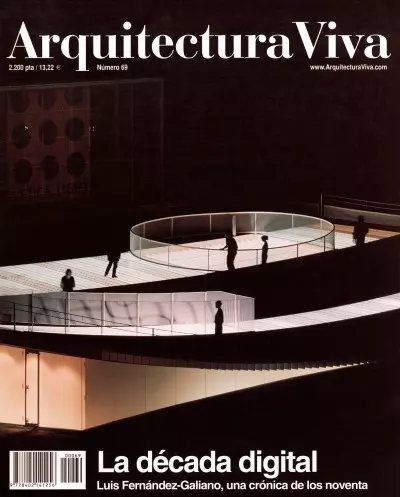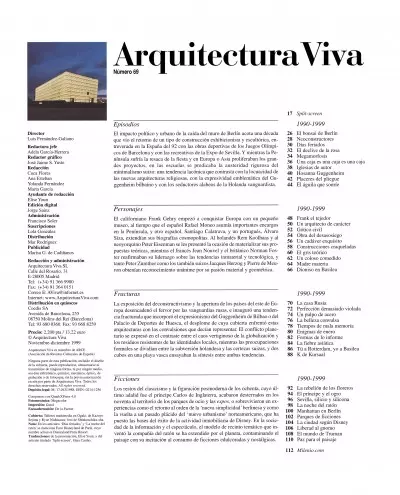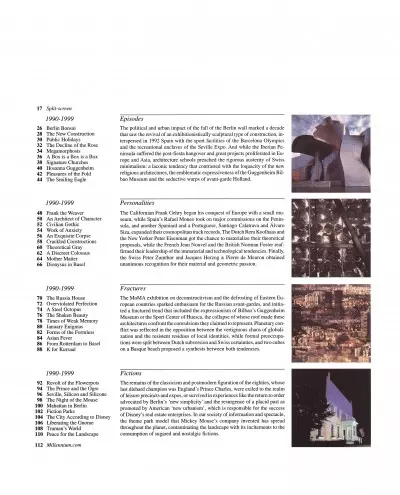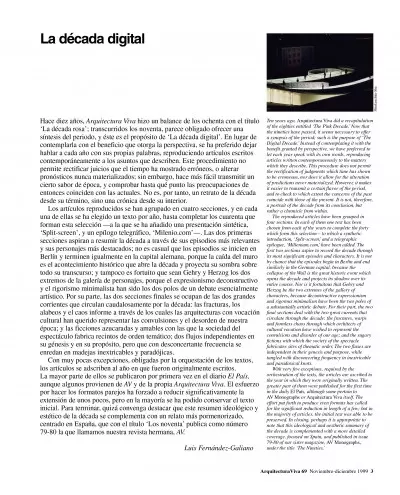Episodes
The political and urban impact of the fall of the Berlin wall marked a decade that saw the revival of an exhibitionistically sculptural type of construction, interspersed in 1992 Spain with the sport facilities of the Barcelona Olympics and the recreational enclaves of the Seville Expo. And while the Iberian Peninsula suffered the post-fiesta hangover and great projects proliferated in Europe and Asia, architecture schools preached the rigorous austerity of Swiss minimalism: a laconic tendency that contrasted with the loquacity of the new religious architectures, the emblematic expressiveness of the Guggenheim Bilbao Museum and the seductive warps of avant-garde Holland.
Split-screen
1990-1999 Berlin Bonsai
The New Construction
Public Holidays
The Decline of the Rose
Megamorphosis
A Box is a Box is a Box
Signature Churches
Hosanna Guggenheim
Pleasures of the Fold
The Smiling Eagle
Personalities
The Californian Frank Gehry began his conquest of Europe with a small museum, while Spain’s Rafael Moneo took on major commissions on the Peninsula, and another Spaniard and a Portuguese, Santiago Calatrava and Alvaro Siza, expanded their cosmopolitan track records. The Dutch Rem Koolhaas and the New Yorker Peter Eisenman got the chance to materialize their theoretical proposals, while the French Jean Nouvel and the British Norman Foster reaffirmed their leadership of the immaterial and technological tendencies. Finally, the Swiss Peter Zumthor and Jacques Herzog & Pierre de Meuron obtained unanimous recognition for their material and geometric passion.
1990-1999
Frank the Weaver
An Architect of Character
Civilian Gothic
Work of Anxiety
An Exquisite Corpse
Crackled Constructions
Theoretical Gray
A Discreet Colossus
Mother Matter
Dionysus in Basel
Fractures
The MoMA exhibition on deconstructivism and the defrosting of Eastern European countries sparked enthusiasm for the Russian avant-gardes, and initiated a fractured trend that included the expressionism of Bilbao’s Guggenheim Museum or the Sport Center of Huesca, the collapse of whose roof made these architectures confront the convulsions they claimed to represent. Planetary conflict was reflected in the opposition between the vertiginous chaos of globalization and the resistant residues of local identities, while formal preoccupations were split between Dutch subversion and Swiss certainties, and two cubes on a Basque beach proposed a synthesis between both tendencies. 1990-1999 The Russia House
Overviolated Perfection
A Steel Octopus
The Shaken Beauty
Times of Weak Memory
January Enigmas
Forms of the Formless
Asian Fever
From Rotterdam to Basel
K for Kursaal
Fictions
The remains of the classicism and postmodern figuration of the eighties, whose last diehard champion was England’s Prince Charles, were exiled to the realm of leisure precincts and expos, or survived in experiences like the return to order advocated by Berlin’s ‘new simplicity’ and the resurgence of a placid past as promoted by American ‘new urbanism’, which is responsible for the success of Disney’s real estate enterprises. In our society of information and spectacle, the theme park model that Mickey Mouse’s company invented has spread throughout the planet, contaminating the landscape with its incitements to the consumption of sugared and nostalgic fictions.
1990-1999
Revolt of the Flowerpots
The Prince and the Ogre
Seville, Silicon and Silicone
The Night of the Mouse
Manhattan in Berlin
Fiction Parks
The City According to Disney
Liberating the Gnome
Truman's World
Peace for the Landscape
Milenio.com
Luis Fernández-Galiano
The Digital Decade
Ten years ago, Arquitectura Viva did a recapitulation of the eighties entitled ‘The Pink Decade.’ Now that the nineties have passed, it seems necessary to offer a synopsis of the period; such is the purpose of ‘The Digital Decade.’ Instead of contemplating it with the benefit granted by perspective, we have preferred to let each year speak with its own words, reproducing articles written contemporaneously to the matters which they describe. This procedure does not permit the rectification of judgments which time has shown to be erroneous, nor does it allow for the alteration ofpredictions never materialized. However, it makes it easier to transmit a certain flavor of the period, and to check to which extent the concerns of the past coincide with those of the present. It is not, therefore, a portrait of the decade from its conclusion, but rather a chronicle from within. The reproduced articles have been grouped in four sections. In each of them one text has been chosen from each of the years to complete the forty which form this selection – to which a synthetic introduction, ‘Split-screen,’ and a telegraphic epilogue, ‘Millenium.com,’ have been added. The first two sections aspire to record the decade through its most significant episodes and characters. It is not by chance that the episodes begin in Berlin and end similarly in the German capital, because the collapse of the Wall is the great historic event which opens the decade and projects its shadow over its entire course. Nor is it fortuitous that Gehry and Herzog be the two extremes of the gallery of characters, because deconstructive expressionism and rigorous minimalism have been the two poles of a substantially artistic debate. For their part, the two final sections deal with the two great currents that circulate through the decade: the fractures, warps and formless chaos through which architects of cultural vocation have wished to represent the convulsions and disorder of our age; and the sugary fictions with which the society of the spectacle fabricates sites of thematic order. The two fluxes are independent in their genesis and purpose, while tangled with disconcerting frequency in inextricable and paradoxical knots. With very few exceptions, required by the orchestration of the texts, the articles are ascribed to the year in which they were originally written. The greater part of them were published for the first time in the daily El País, although some pertain to AV Monographs or Arquitectura Viva itself. The effort put forth to produce even formats has called for the significant reduction in length of a few; but in the majority of articles, the initial text was able to be preserved. In closing, perhaps it is appropriate to note that this ideological and aesthetic summary of the decade is complemented with a more detailed coverage, focused on Spain, and published in issue 79-80, of our sister magazine, AV Monographs, under the title ‘The Nineties.’








